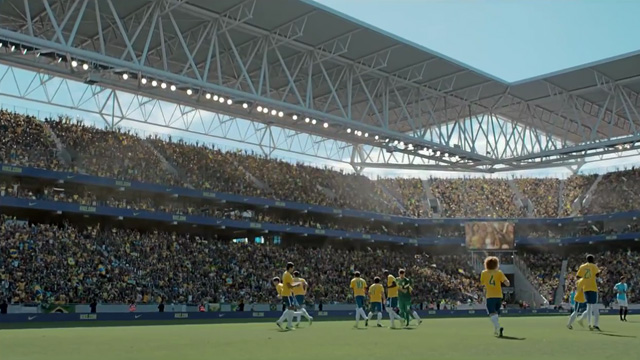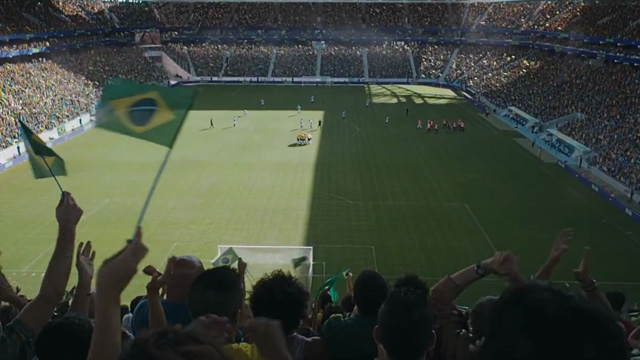Framestore Creates Brazilian Crowds for Nike
Framestore was responsible for all visual effects in the last Nike commercial for the launch of Brazil World Cup 2014 kit. The team used Golaem Crowd to populate the stadium with 40 000 people.
The Nike - Dare to be Brazilian campaign reminds us that “Nobody plays like Brazil”. It features Brazilian All Stars and loads of visual effects including giant players, cartoon style action… and the crowd as the 12th player. According to VFX Supervisor William Bartlett, the challenge of this production was to produce a huge range of work in a very short time.
The commercial used a combination of 2D and 3D crowds. The 2D crowds had been created with live-action sprites filmed on location, and as these were obviously locked into certain lighting/motions scenarios, they naturally became the target for the Golaem crowd to match.
CG Lead, Robert Harrington, explains “We knew the size of the audience on screen meant we didn't need particularly complicated clothing geometry, but their appearance did need some textural noise. With this in mind we created a lot of textural variations, both for clothes and skin (everyone loves some face-paint), and connected them to the Golaem Crowd procedural shaders for randomization. It was a predictably straight-forward workflow (which is good).”
“The character asset was lookdev'd in the same way we do all our work, and despite the specific Golaem Crowd asset management workflow, it fitted easily into our pipeline. The end result was, once you had the shaders in the final lighting scene, it just became a typical Arnold mtoa rendering workflow”.


Concerning crowd simulation itself: “The scene-population followed the equally-predictable stadium workflow. Using some recce-photos, we made a proxy model of the stadium with one face per seat-area and enough geometry for generally-correct shadow casting. It was then easily populated using the Golaem Crowd Population Tool.”
“From here, the last thing to solve was the motion capture. We generated numerous Golaem Crowd motion clips from our stadium-like motion capture. The motions themselves were not looping but were quite long, meaning we could configure Golaem Crowd to randomize each character's start frame whilst also not reaching the end of a motion during a shot. We then studied the adjoining 2D shots, creating the characters’ behaviour by connecting various clips to a random operator (along with some trigger events here and there) and giving different weights until the variety of motions blended enough.”
Finally, shots were rendered using Arnold together with the Golaem Crowd procedural plugin: “Render memory usage varied depending on certain factors, but it was not uncommon to be rendering 18,000 people and only use 7GB of memory.”
Robert Harrington concludes “Our small, controlled team turned the 3D work around in a few weeks, and whilst that does take planning, it was also entirely feasible, renderable and predictable... and that says a lot about how capable Golaem is.”
